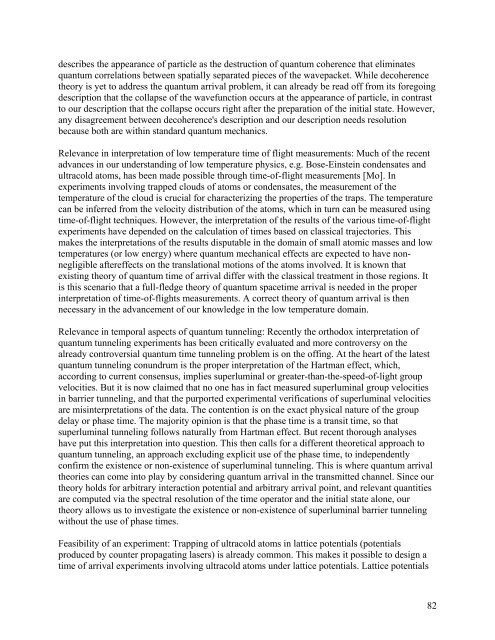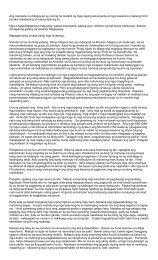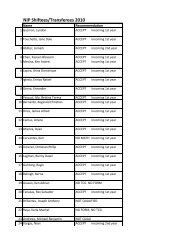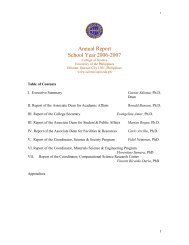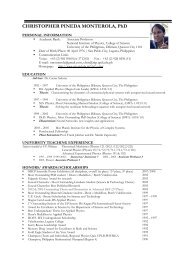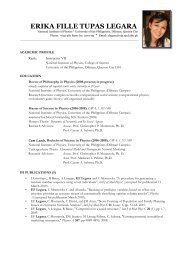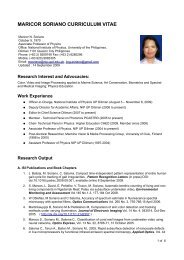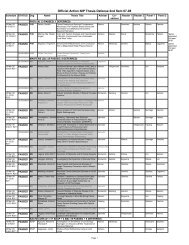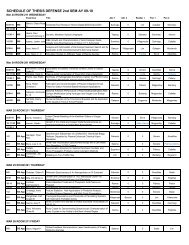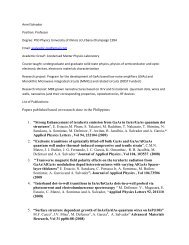NIP REPORT January 2006- May 2007 - The UP College of Science ...
NIP REPORT January 2006- May 2007 - The UP College of Science ...
NIP REPORT January 2006- May 2007 - The UP College of Science ...
Create successful ePaper yourself
Turn your PDF publications into a flip-book with our unique Google optimized e-Paper software.
describes the appearance <strong>of</strong> particle as the destruction <strong>of</strong> quantum coherence that eliminates<br />
quantum correlations between spatially separated pieces <strong>of</strong> the wavepacket. While decoherence<br />
theory is yet to address the quantum arrival problem, it can already be read <strong>of</strong>f from its foregoing<br />
description that the collapse <strong>of</strong> the wavefunction occurs at the appearance <strong>of</strong> particle, in contrast<br />
to our description that the collapse occurs right after the preparation <strong>of</strong> the initial state. However,<br />
any disagreement between decoherence's description and our description needs resolution<br />
because both are within standard quantum mechanics.<br />
Relevance in interpretation <strong>of</strong> low temperature time <strong>of</strong> flight measurements: Much <strong>of</strong> the recent<br />
advances in our understanding <strong>of</strong> low temperature physics, e.g. Bose-Einstein condensates and<br />
ultracold atoms, has been made possible through time-<strong>of</strong>-flight measurements [Mo]. In<br />
experiments involving trapped clouds <strong>of</strong> atoms or condensates, the measurement <strong>of</strong> the<br />
temperature <strong>of</strong> the cloud is crucial for characterizing the properties <strong>of</strong> the traps. <strong>The</strong> temperature<br />
can be inferred from the velocity distribution <strong>of</strong> the atoms, which in turn can be measured using<br />
time-<strong>of</strong>-flight techniques. However, the interpretation <strong>of</strong> the results <strong>of</strong> the various time-<strong>of</strong>-flight<br />
experiments have depended on the calculation <strong>of</strong> times based on classical trajectories. This<br />
makes the interpretations <strong>of</strong> the results disputable in the domain <strong>of</strong> small atomic masses and low<br />
temperatures (or low energy) where quantum mechanical effects are expected to have nonnegligible<br />
aftereffects on the translational motions <strong>of</strong> the atoms involved. It is known that<br />
existing theory <strong>of</strong> quantum time <strong>of</strong> arrival differ with the classical treatment in those regions. It<br />
is this scenario that a full-fledge theory <strong>of</strong> quantum spacetime arrival is needed in the proper<br />
interpretation <strong>of</strong> time-<strong>of</strong>-flights measurements. A correct theory <strong>of</strong> quantum arrival is then<br />
necessary in the advancement <strong>of</strong> our knowledge in the low temperature domain.<br />
Relevance in temporal aspects <strong>of</strong> quantum tunneling: Recently the orthodox interpretation <strong>of</strong><br />
quantum tunneling experiments has been critically evaluated and more controversy on the<br />
already controversial quantum time tunneling problem is on the <strong>of</strong>fing. At the heart <strong>of</strong> the latest<br />
quantum tunneling conundrum is the proper interpretation <strong>of</strong> the Hartman effect, which,<br />
according to current consensus, implies superluminal or greater-than-the-speed-<strong>of</strong>-light group<br />
velocities. But it is now claimed that no one has in fact measured superluminal group velocities<br />
in barrier tunneling, and that the purported experimental verifications <strong>of</strong> superluminal velocities<br />
are misinterpretations <strong>of</strong> the data. <strong>The</strong> contention is on the exact physical nature <strong>of</strong> the group<br />
delay or phase time. <strong>The</strong> majority opinion is that the phase time is a transit time, so that<br />
superluminal tunneling follows naturally from Hartman effect. But recent thorough analyses<br />
have put this interpretation into question. This then calls for a different theoretical approach to<br />
quantum tunneling, an approach excluding explicit use <strong>of</strong> the phase time, to independently<br />
confirm the existence or non-existence <strong>of</strong> superluminal tunneling. This is where quantum arrival<br />
theories can come into play by considering quantum arrival in the transmitted channel. Since our<br />
theory holds for arbitrary interaction potential and arbitrary arrival point, and relevant quantities<br />
are computed via the spectral resolution <strong>of</strong> the time operator and the initial state alone, our<br />
theory allows us to investigate the existence or non-existence <strong>of</strong> superluminal barrier tunneling<br />
without the use <strong>of</strong> phase times.<br />
Feasibility <strong>of</strong> an experiment: Trapping <strong>of</strong> ultracold atoms in lattice potentials (potentials<br />
produced by counter propagating lasers) is already common. This makes it possible to design a<br />
time <strong>of</strong> arrival experiments involving ultracold atoms under lattice potentials. Lattice potentials<br />
82


